Sonic Heritage of Medieval Bells from the Valdres Region of Norway
Abstract
1. Introduction
- To document the tonal characteristics of medieval bells from Valdres;
- To explore possible medieval tuning practices;
- To discuss the cultural significance of medieval bells as carriers of medieval sonic heritage.
2. Materials and Methods
2.1. Medieval Bells in the Valdres Region
2.2. Archaeoacoustic Methods
2.2.1. Fieldwork Acoustic Measurements
2.2.2. Post-Processing of Bell Recordings
2.2.3. Tonal Analysis of Bells
3. Results: Tonal Structure of Medieval Bells from Valdres
- ▪
- Harmonic—a whole-number frequency ratio;
- ▪
- Mildly harmonic—not exact whole-number frequency ratio, but still close enough to sound consonant;
- ▪
- Mildly inharmonic—deviates from a whole-number frequency ratio and begins to sound noticeably off, though not severely dissonant;
- ▪
- Inharmonic—deviates significantly from an ideal harmonic ratio, often resulting in perceptible dissonance.
- ▪
- Open consonance—octave, perfect fifth—sound pure and stable;
- ▪
- Soft consonance—major/minor third, major/minor sixth—still sounds pleasant, but with mild tension;
- ▪
- Mild dissonance—major second, minor seventh—sound tense or unstable;
- ▪
- Sharp dissonance—minor second, major seventh, tritone (augmented fourth/diminished fifth)—sounds highly tense, biting, piercing;
- ▪
- Exception—perfect fourth (can be considered consonant in dissonant surroundings and dissonant in consonant surroundings).
4. Discussion
4.1. Rediscovering Medieval Bell Tuning
“Sitting in my dining room, with outer and inner doors shut, I was struck by the singularly sweet sound of our six little Fittleworth bells as heard down the chimney. On opening the doors so as to hear them directly, I observed with surprise that the scale was different, and I finally discovered that what I had heard down the chimney were the hum-notes, which alone found their way to me by this devious course. After this experience, we cannot dismiss the hum-notes as unworthy of careful attention.”
4.2. Medieval Bells as Sonic Heritage: Implications for Heritage Preservation and Community Identity
5. Conclusions
Author Contributions
Funding
Data Availability Statement
Acknowledgments
Conflicts of Interest
References
- Parker, M.; Spennemann, D.H.R. Classifying Sound: A Tool to Enrich Intangible Heritage Management. Acoust. Aust. 2022, 50, 23–39. [Google Scholar] [CrossRef]
- Parker, M.; Spennemann, D.H. Conceptualising Sound Making and Sound Loss in the Urban Heritage Environment. Int. J. Urban Sustain. Dev. 2022, 14, 264–286. [Google Scholar] [CrossRef]
- Girón, S.; Álvarez-Morales, L.; Zamarreño, T. Church Acoustics: A State-of-the-Art Review after Several Decades of Research. J. Sound Vib. 2017, 411, 378–408. [Google Scholar] [CrossRef]
- Đorđević, Z.; Novković, D.; Dragišić, M. Intangible Mosaic of Sacred Soundscapes in Medieval Serbia. Acoustics 2022, 5, 28–45. [Google Scholar] [CrossRef]
- Palazzo-Bertholon, B.; Valière, J.-C. (Eds.) Archéologie du Son: Les Dispositifs de Pots Acoustiques Dans Les Édifices Anciens; Bulletin Monumental, Suppl. 5; Picard: Paris, France, 2012; ISBN 978-2-901837-41-1. [Google Scholar]
- López, M.J. Sonic Pasts: Acoustical Heritage and Historical Soundscapes; Routledge, Taylor & Francis Group: London, UK; New York, NY, USA, 2025; ISBN 978-1-03-230005-4. [Google Scholar]
- Alvarez-Morales, L.; Díaz-Andreu, M. Acoustics, Soundscapes and Sounds as Intangible Heritage. Acoustics 2024, 6, 408–412. [Google Scholar] [CrossRef]
- Đorđević, Z.; Dragišić, M.; Manzetti, M.C.; Novković, D. Digitization of Acoustic Heritage in a Service of Protection, Research and Promotion of European Cultural Heritage. In Digital Cultural Heritage; Springer: Cham, Switzerland, 2019; pp. 433–447. ISBN 978-3-030-15198-0. [Google Scholar]
- Đorđević, Z. Intangible Tangibility: Acoustical Heritage in Architecture. Struct. Integr. Life 2016, 16, 59–66. [Google Scholar]
- Boynton, S.; Reilly, D.J. (Eds.) Resounding Images: Medieval Intersections of Art, Music, and Sound; Studies in the visual cultures of the Middle Ages; Brepols: Turnhout, Belgium, 2015; ISBN 978-2-503-55437-2. [Google Scholar]
- Fenlon, I. (Ed.) Music in Medieval and Early Modern Europe: Patronage, Sources and Texts; Digitally print; Cambridge University Press: Cambridge, UK, 2009; ISBN 978-0-521-10738-9. [Google Scholar]
- Knighton, T.; Fallows, D. (Eds.) Companion to Medieval and Renaissance Music; University of California Press: Berkeley, CA, USA, 2001; ISBN 978-0-520-21081-3. [Google Scholar]
- Williams, E.V. The Bells of Russia: History and Technology; Princeton University Press: Princeton, NJ, USA, 1985; ISBN 978-0-691-09131-0. [Google Scholar]
- Price, P. Bells and Man; Oxford University Press: Oxford, UK, 1983; ISBN 978-0-19-318103-8. [Google Scholar]
- Lears, A.E. On Bells and Rebellion: The Auditory Imagination and Social Reform, Medieval and Modern. In Vernacular Aesthetics in the Later Middle Ages; Jager, K.W., Ed.; Springer International Publishing: Cham, Switzerland, 2019; pp. 87–115. ISBN 978-3-030-18333-2. [Google Scholar]
- Arnold, J.H.; Goodson, C. Resounding Community: The History and Meaning of Medieval Church Bells. Viator 2012, 43, 99–130. [Google Scholar] [CrossRef]
- Garceau, M.E. ‘I Call the People.’ Church Bells in Fourteenth-Century Catalunya. J. Mediev. Hist. 2011, 37, 197–214. [Google Scholar] [CrossRef]
- Đorđević, Z.; Costa Badia, X.; González Vázquez, N.; Alvarez-Morales, L. Unveiling the Historical Significance of Santa Maria D’Àneu: Can Soundscape Studies Illuminate Its Role Within the Medieval Ecclesiastical Structure? Stud. Univ. Hered. 2024, 12, 65–84. [Google Scholar] [CrossRef]
- Bertoldi, S.; Castiglia, G.; Castrorao Barba, A.; Menghini, C. Soundscape and Catchment Analysis for a Spatial Geography of Medieval Monastic Estates in Southeastern Tuscany (11th-12th Centuries). Archeol. E Calc. 2022, 33, 95–114. [Google Scholar] [CrossRef]
- Primeau, K.E. A GIS Approach to Landscape Scale Archaeoacoustics. Ph.D. Thesis, University of Albany—State University of New York, New York, NY, USA, 2022. [Google Scholar]
- Atkinson, N. The Noisy Renaissance: Sound, Architecture, and Florentine Urban Life; The Pennsylvania State University Press: University Park, PA, USA, 2016; ISBN 978-0-271-07120-6. [Google Scholar]
- Mileson, S. Sound and Landscape. In Oxford Handbook of Medieval Archaeology; Gerrard, C., Gutierrez, A., Eds.; Oxford University Press: Oxford, UK, 2016; pp. 713–727. [Google Scholar]
- UNESCO Convention for the Safeguarding of the Intangible Cultural Heritage. 2003. Available online: https://ich.unesco.org/en/convention (accessed on 15 March 2025).
- UNESCO Representative List of the Intangible Cultural Heritage of Humanity—Manual Bell Ringing; Spain, Italy. 2024. Available online: https://ich.unesco.org/en/RL/manual-bell-ringing-02100 (accessed on 20 March 2025).
- Pietroni, E. Mapping the Soundscape in Communicative Forms for Cultural Heritage: Between Realism and Symbolism. Heritage 2021, 4, 4495–4523. [Google Scholar] [CrossRef]
- Pennanen, R.P. Cannons, Church Bells and Colonial Policies: The Soundscape in Habsburg Bosnia-Herzegovina. In Cultural Histories of Noise, Sound and Listening in Europe, 1300–1918; Biddle, I.D., Gibson, K., Eds.; Routledge, Taylor & Francis Group: London, UK; New York, NY, USA, 2017; pp. 166–180. ISBN 978-1-4094-4440-4. [Google Scholar]
- Eckardt, H.; Williams, S. The Sound of Magic? Bells in Roman Britain. Britannia 2018, 49, 179–210. [Google Scholar] [CrossRef]
- Sjöstrand, E. Om Klockrent: A Very Large Concert by Karin Rehnqvist, Claes Holmgren Och Owe Ronström; eddy.se: Visby, Sweden, 2020; ISBN 978-91-88929-31-0. [Google Scholar]
- Corbin, A. Village Bells: Sound and Meaning in the Nineteenth-Century French Countryside; European perspectives; Columbia University Press: New York, NY, USA, 1998; ISBN 978-0-231-10450-0. [Google Scholar]
- Schafer, R.M. The Tuning of the World, 1st ed.; Alfred A. Knopf: New York, NY, USA, 1977; ISBN 978-0-394-40966-5. [Google Scholar]
- Sjöstrand, E. (Swedish Radio, Stockholm, Swenden). Personal communication, 2025.
- Theophilus, P. On Divers Arts—The Treatise of Theophilus; The University of Chicago Press: Chicago, IL, USA, 1963. [Google Scholar]
- Asmus, B. Bridging the Past and Present by Skill: Exploring Medieval Bell Casting by Experiment. Hist. Metall. 2024, 54, 85–102. [Google Scholar] [CrossRef]
- Lehr, A. The Designing of Swinging Bells and Carillon Bells in the Past and Present; Athanasius Kircher Foundation: Asten, The Netherlands, 1987. [Google Scholar]
- de Groot, T. Sluttrapport for Prosjektet Registrering Av Norges Kirkeklokker Fra Middelalderen; Riksantikvaren: Oslo, Norway, 2015; p. 67. [Google Scholar]
- Andersen, H. Church Bells in Valdres. 2020. Available online: https://www.kyrkjeklokker.no/kyrkjeklokker-i-valdres/ (accessed on 20 March 2025).
- Joranger, T.M.H. The Migration of Tradition: Land Tenure and Culture in the U.S. Upper Mid-West. Eur. J. Am. Stud. 2008, 3, 1–18. [Google Scholar] [CrossRef]
- Havran, J. (Ed.) Norwegian Stave Churches: A Guide to the 29 Remaining Stave Churches; ARFO: Oslo, Norway, 2010; ISBN 978-82-91399-35-5. [Google Scholar]
- Andersen, H. Hedalen Stave Church. Available online: https://www.kyrkjeklokker.no/hedalen-stavkyrkje/ (accessed on 15 May 2025).
- Andersen, H. (Valdres Gravferdsbyrå, Fagernes, Norway). Personal communication, 2024.
- Rossing, T.D.; Perrin, R. Vibrations of Bells. Appl. Acoust. 1987, 20, 41–70. [Google Scholar] [CrossRef]
- Hibbert, W.A. Bell Waveform Analysis Program—Documentation, Version 1.7. 2004. Available online: https://www.hibberts.co.uk/wp-content/uploads/2021/12/wavdoc.pdf (accessed on 10 March 2025).
- Rossing, T.D. The Acoustics of Bells. Am. Sci. 1984, 72, 440–447. [Google Scholar]
- Persichetti, V. Twentieth-Century Harmony: Creative Aspects and Practice; W. W. Norton & Company: New York, NY, USA; London, UK, 2002; ISBN 978-0-393-09539-5. [Google Scholar]
- von Helmholtz, H. On the Sensations of Tone as a Physiological Basis for the Theory of Music, 3rd ed.; Pearson Longman: London, UK, 1895. [Google Scholar]
- Simpson, C.A.B. On Bell Tones I. Pall Mall Mag. 1895, VII, 183–194. [Google Scholar]
- Simpson, C.A.B. On Bell Tones II. Pall Mall Mag. 1896, X, 150–155. [Google Scholar]
- Terhardt, E. Pitch, Consonance, and Harmony. J. Acoust. Soc. Am. 1974, 55, 1061–1069. [Google Scholar] [CrossRef]
- Fletcher, N.H.; Rossing, T.D. The Physics of Musical Instruments; Springer: New York, NY, USA, 1998; ISBN 978-1-4419-3120-7. [Google Scholar]
- McLachlan, N.; Nigjeh, B.K.; Hasell, A. The Design of Bells with Harmonic Overtones. J. Acoust. Soc. Am. 2003, 114, 505–511. [Google Scholar] [CrossRef]
- Samolov, A. Analysis of Just Noticeable Difference in Spectrum of Church Bell Sound. Telflor J. 2010, 2, 82–85. [Google Scholar]
- Salom, I.M.; Mijić, M.M.; Ćertić, J.D.; Šumarac Pavlović, D.S.; Despot, B.D. Subjective Evaluation and an Objective Measure of a Church Bell Sound Quality. Appl. Acoust. 2014, 85, 97–105. [Google Scholar] [CrossRef]
- Rupp, A.; Spiess, D.; Plitzner, M. Simulation des Klöppelanschlags—Einfluss der Klöppelgestaltung auf die Beanspruchung und den Klang der Glocke. In Proceedings of the DAGA 2021—47th Annual Conference on Acoustics, Wien, Austria, 15 August 2021. [Google Scholar]
- Hommedal, A.T. A Bell Foundry in Sola Church: Bell-Casting and Coin Finds in Medieval Norway. Schweiz. Numis. Rundsch. 2019, 97, 245–266. [Google Scholar] [CrossRef]
- Tveit, M. Governing Urban Space through Sound: Aural and Audible Procedures in Norwegian Town Laws. Coll. Mediev. 2024, 37, 35–57. [Google Scholar]
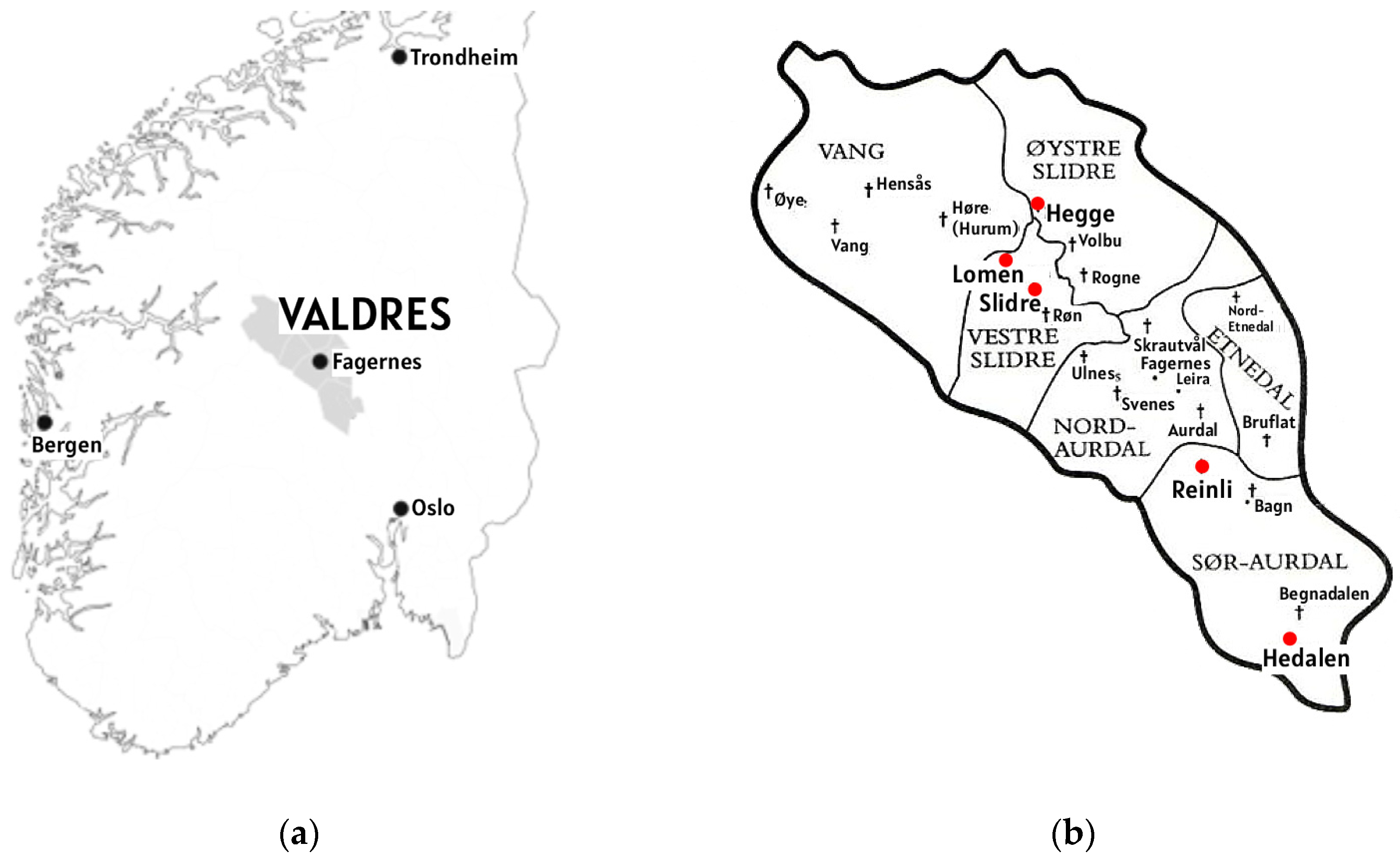
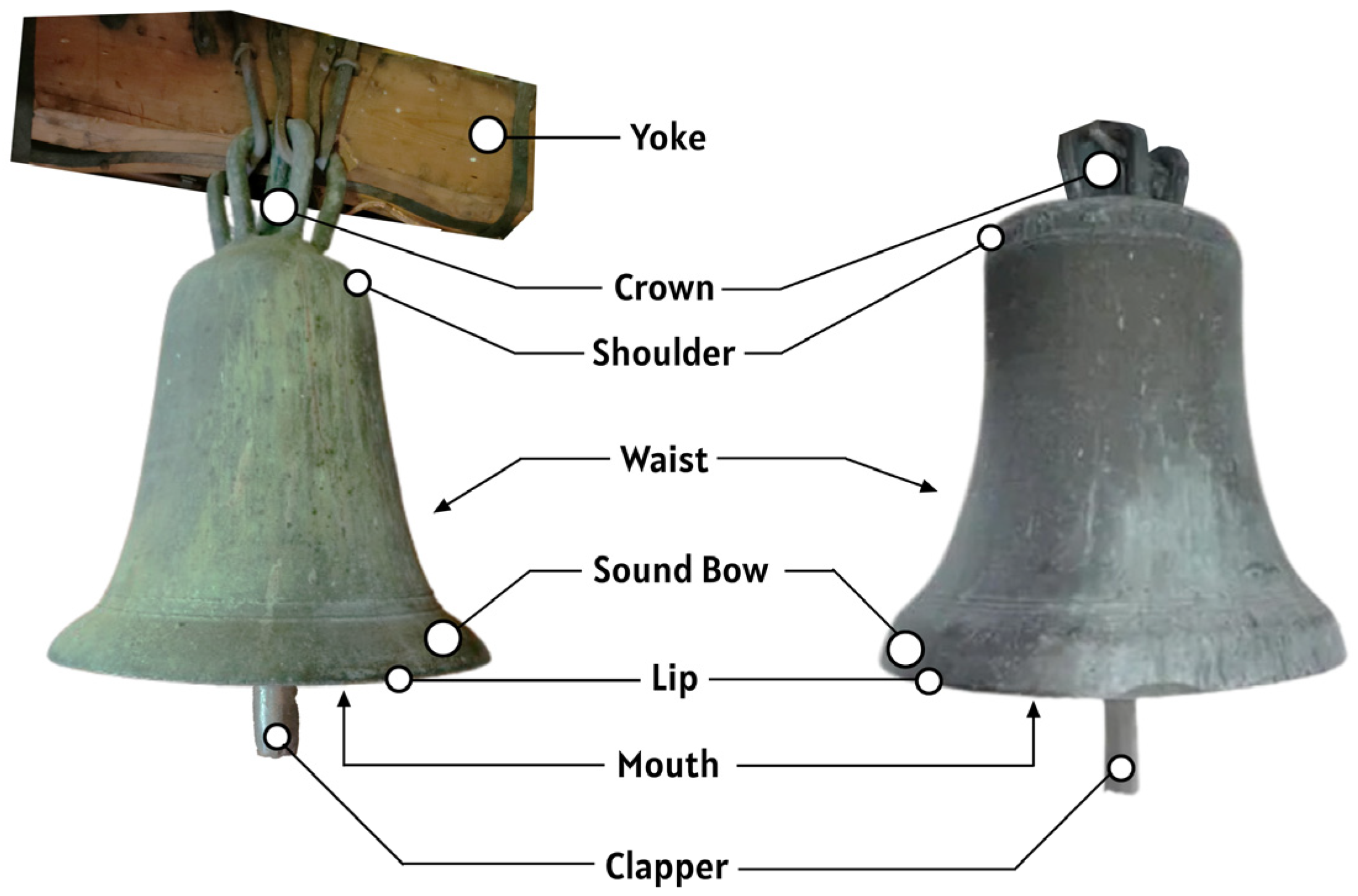

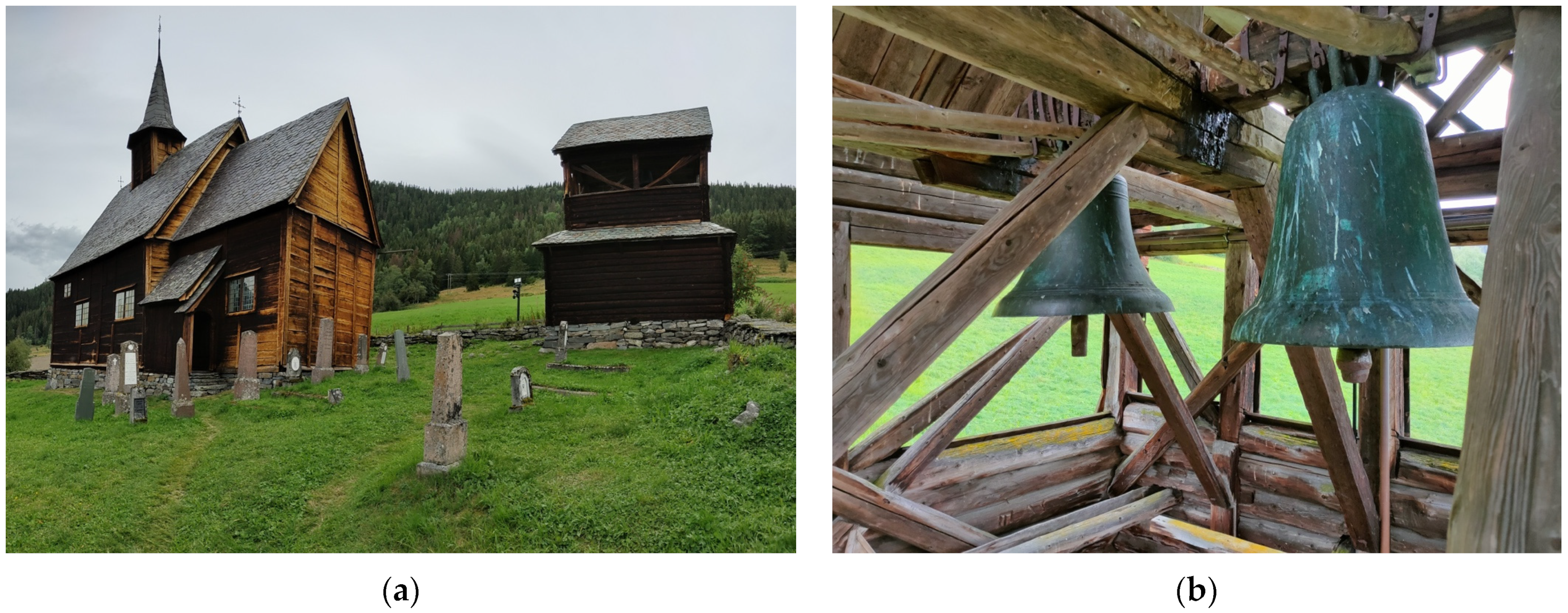
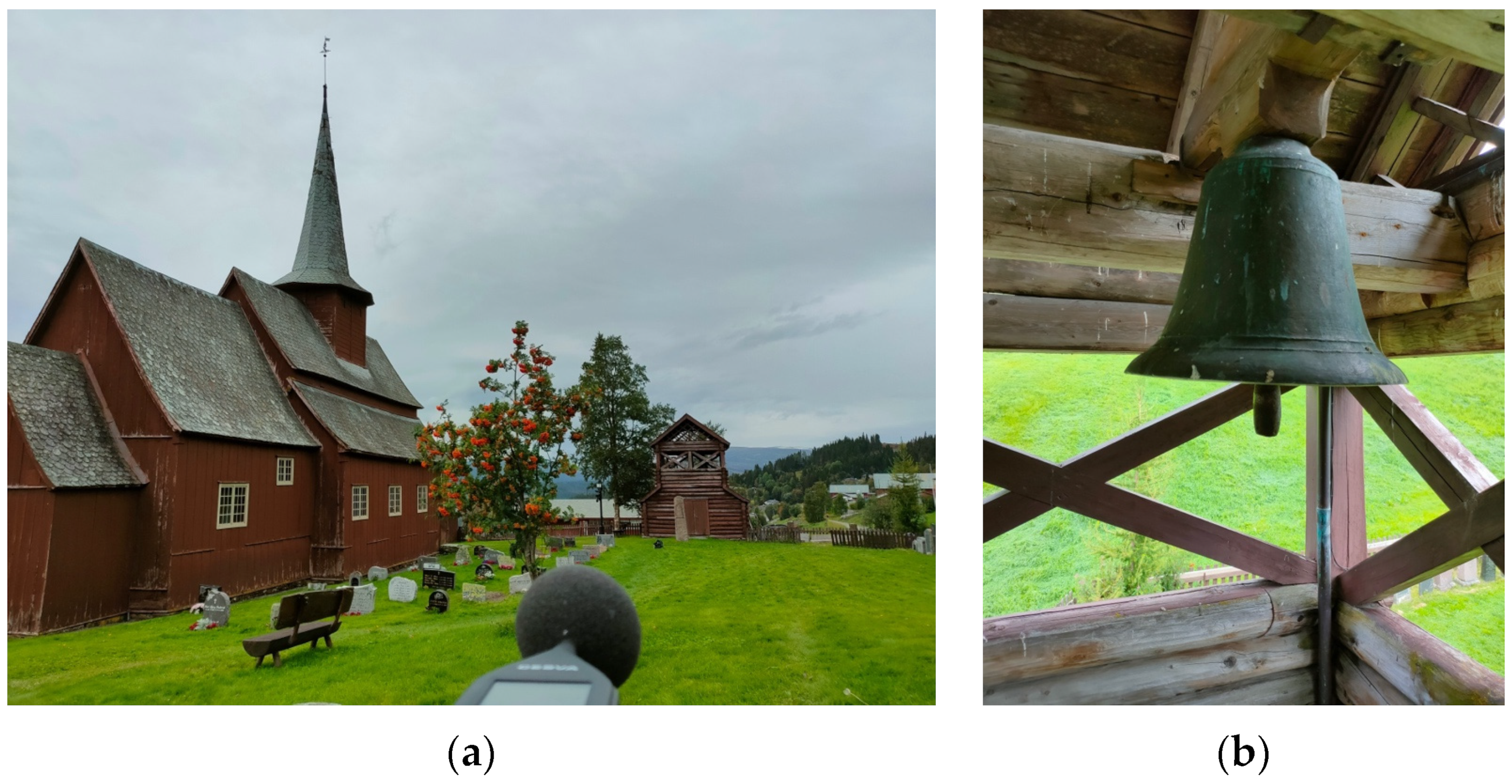
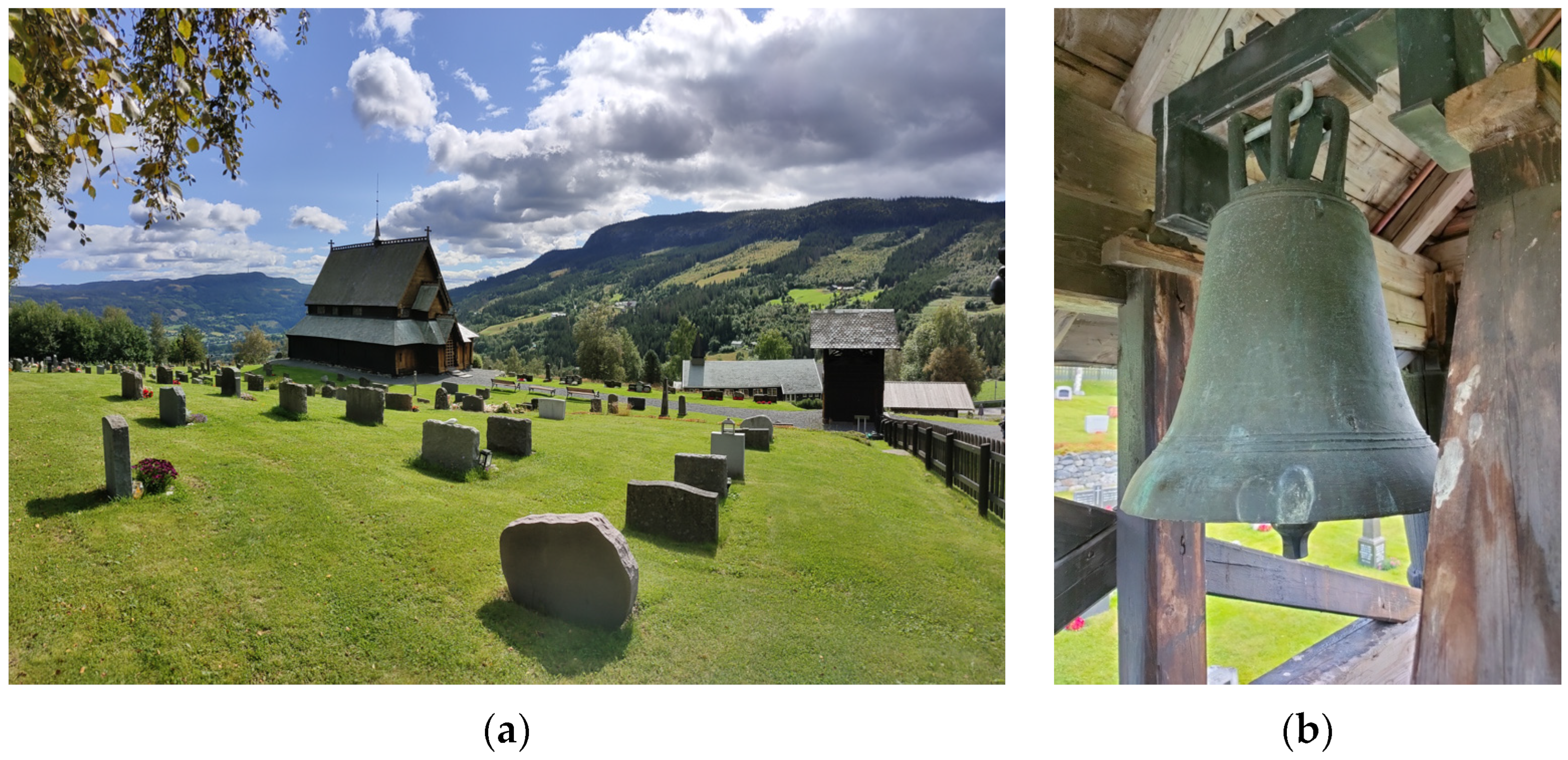
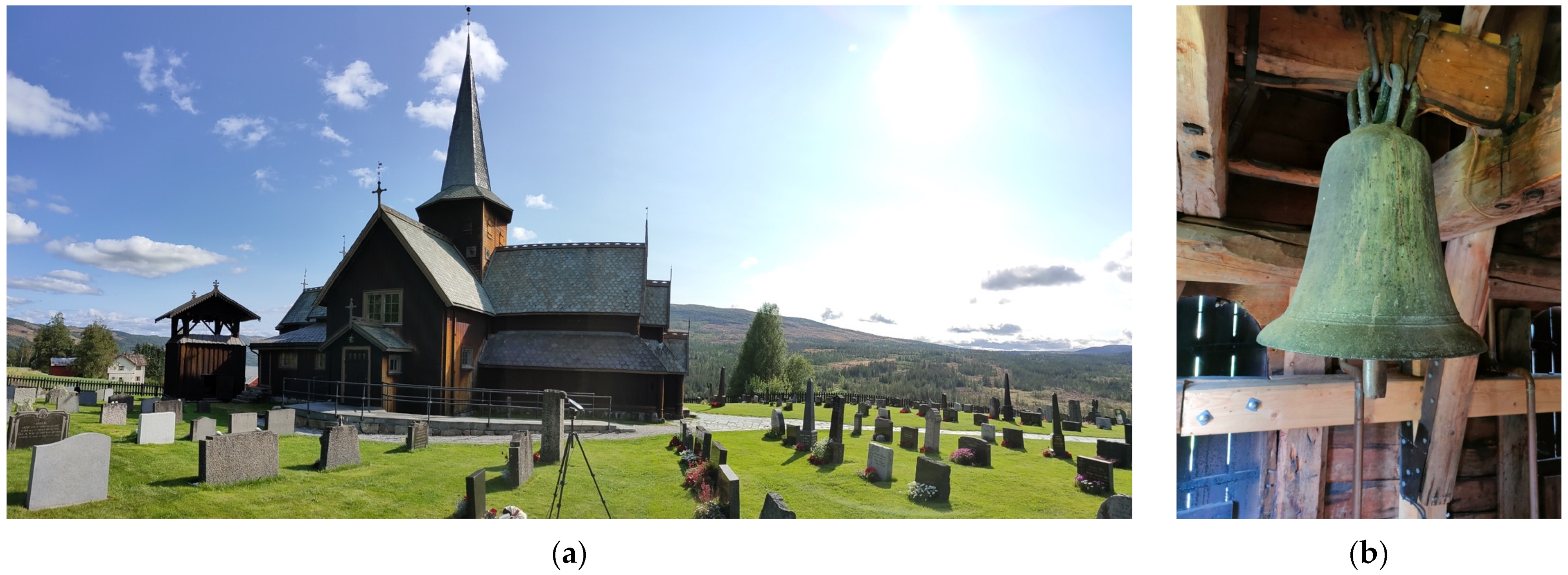

| Church (Century of Building) 1 | Medieval Bells ID | Position of Bells | Approximate Dating of Bells 2 | Size of Bells [cm] Outer Diameter/Height + Crown |
|---|---|---|---|---|
| Slidredomen church 12th c. | SL01 | Bell turret | Mid-14th-mid-15th c. | 60/53 + 10 |
| SL02 | Bell turret | First half of the 13th c. | 61/55 + 17 | |
| SL03 | Bell turret | First half of the 13th c. | 58/56 + 18 | |
| SL04 | Bell turret | Mid-14th c. | 54/50 + 10 | |
| SL05 | Campanile | n/a | 90/77 + 18 | |
| Lomen stave church End of 12th c. | LO01 | Campanile | Mid-12th c. | n/a |
| LO02 | Campanile | Mid-14th c. | n/a | |
| Hegge stave church 13th c. | HEG01 | Campanile | 12th c. | 49/n/a |
| HEG02 | Campanile | 13th c. | 47.5/n/a | |
| Reinli stave church 13–14th c. | RE01 | Campanile | n/a | n/a |
| Hedalen stave church Mid-13th c. | HED01 | Bell turret | Mid-12th c. | 46/43 + 15 |
| HED02 | Campanile | 14th c. | 63/56 + n/a |
| Partial | Musical Interval | Interval in Cents |
|---|---|---|
| Hum | Two octaves below nominal | −2400 |
| Prime | One octave below nominal | −1200 |
| Tierce | Minor third above prime | −900 |
| Quint | Perfect fifth above prime | −500 |
| Nominal | Unison | 0 |
| PARTIAL | MEDIEVAL BELLS IN VALDRES | ||||||||||
|---|---|---|---|---|---|---|---|---|---|---|---|
| THT | SL01 | SL02 | SL03 | SL04 | LO01 | LO02 | HEG01 | RE01 | HED01 | HED02 | |
| Hum | −2400 | −2424 | −2676 | −2600 | −2696 | −2168 | −2219 | −2674 | −2497 | −2531 | −2437 |
| Prime | −1200 | −1472 | −1390 | −1024 | −1216 | −1450 | −1449 | −1223 | −1056 | −1435 | −1525 |
| Tierce | −900 | −921 | −970 | −877 | −980 | −816 | −894 | −972 | −778 | −886 | −950 |
| Quint | −500 | −597 | −840 | −760 | −653 | −561 | −236 | −712 | −648 | −729 | −555 |
| Nominal | 0 | 0 | 0 | 0 | 0 | 0 | 0 | 0 | 0 | 0 | 0 |
| True nominal | 0 | 1298 | 1553 | 1200 | 1367 | 2330 | 1216 | 2039 | 1303 | 1987 | 1829 |
| BELL | Partial | Frequency (Hz) | Musical Note +/− Cents | Ideal Musical Interval (Fr. Ratio to Prime) | Closest Musical Interval (Fr. Ratio to Prime) | Harmonicity (Closest Integer Ratio) | Consonance |
|---|---|---|---|---|---|---|---|
| Hum | 320 | Eb(4) + 49 | Octave below (0.5) | Minor seventh below prime (0.577) | Inharmonic | Mild dissonance | |
| Prime | 554.5 | Db(5) + 0 | Unison | Unison | Reference | Reference | |
| SL01 | Tierce | 762.5 | G(5) − 47 | Minor third (1.2) | Augmented fourth (1.375) | Midly harmonic (11:8) | Mild dissonance |
| Quint | 919.5 | Bb(5) − 23 | Perfect fifth (1.5) | Major sixth (1.658) | Harmonic (5:3) | Soft consonance | |
| Nominal | 1298 | E(6) − 26 | Octave (2.0) | Octave + minor third (2.340) | Mildly harmonic | Soft consonance | |
| Hum | 331 | E(4) + 10 | Octave below (0.5) | Major 7th below prime (0.476) | Inharmonic | Sharp dissonance | |
| Prime | 695 | F(5) − 8 | Unison | Unison | Reference | Reference | |
| SL02 | Tierce | 886.5 | A(5) + 13 | Minor third (1.2) | Major third (1.276) | Mildly inharmonic | Soft consonance |
| Quint | 954.5 | Bb(5) + 41 | Perfect fifth (1.5) | Perfect fourth (1.373) | Harmonic (11:8) | Soft consonance | |
| Nominal | 1553.5 | G(6) − 15 | Octave (2.0) | Octave + major second (2.235) | Midly harmonic (9:4) | Mild dissonance | |
| Hum | 267 | C(4) + 35 | Octave below (0.5) | Octave + major third below prime (0.402) | Mildly harmonic (2:5) | Soft consonance | |
| Prime | 664.5 | E(5) + 14 | Unison | Unison | Reference | Reference | |
| SL03 | Tierce | 723 | F#(5) − 39 | Minor third (1.2) | Major second (1.088) | Inharmonic | Mild dissonance |
| Quint | 773.5 | G(5) − 22 | Perfect fifth (1.5) | Minor third (1.164) | Inharmonic | Soft consonance | |
| Nominal | 1200 | D(6) + 37 | Octave (2.0) | Major seventh (1.806) | Mildly harmonic (9:5) | Sharp dissonance | |
| Hum | 288.5 | D(4) − 30 | Octave below (0.5) | Octave + major second below prime (0.426) | Mildly inharmonic | Mild dissonance | |
| Prime | 677.5 | E(5) + 47 | Unison | Unison | Reference | Reference | |
| SL04 | Tierce | 775.5 | G(5) − 18 | Minor third (1.2) | Minor third (1.145) | Inharmonic | Soft consonance |
| Quint | 937.5 | Bb(5) + 10 | Perfect fifth (1.5) | Diminished fifth (1.384) | Mildly harmonic | Sharp dissonance | |
| Nominal | 1367 | F(6) − 36 | Octave (2.0) | Octave + 17 cents (2.018) | Mildly inharmonic | Soft consonance | |
| Hum | 666 | E(5) + 18 | Octave below (0.5) | Perfect fifth below prime (0.660) | Mildly harmonic (2:3) | Open consonance | |
| Prime | 1008.5 | B(5) + 36 | Unison | Unison | Reference | Reference | |
| LO01 | Tierce | 1454 | F#(6) + 30 | Minor third (1.2) | Perfect fifth (1.442) | Mildly inharmonic (7:5) | Open consonance |
| Quint | 1685 | Ab(6) + 25 | Perfect fifth (1.5) | Minor seventh (1.671) | Mildly harmonic (5:3) | Mild dissonance | |
| Nominal | 2330.5 | D(7) − 13 | Octave (2.0) | Octave + minor third (2.311) | Mildly inharmonic | Soft consonance | |
| Hum | 337.5 | E(4) + 41 | Octave below (0.5) | Minor sixth below prime (0.641) | Mildly inharmonic (5:8) | Soft consonance | |
| Prime | 526.5 | C(5) + 11 | Unison | Unison | Reference | Reference | |
| LO02 | Tierce | 725.5 | F#(5) − 33 | Minor third (1.2) | Augmented fourth (1.378) | Mildly harmonic (11:8) | Sharp dissonance |
| Quint | 1060.5 | C(6) + 23 | Perfect fifth (1.5) | Octave (2.015) | Harmonic (sharp) | Open consonance | |
| Nominal | 1216 | Eb(6) − 39 | Octave (2.0) | Octave + minor third (2.310) | Mildly inharmonic (7:3) | Soft consonance | |
| Hum | 435.5 | A(4) − 17 | Octave below (0.5) | Octave + major second below prime (0.433) | Mildly inharmonic (7:16) | Mild dissonance | |
| Prime | 1006.5 | B(5) + 33 | Unison | Unison | Reference | Reference | |
| HEG01 | Tierce | 1163.5 | D(6) − 16 | Minor third (1.2) | Minor third (1.156) | Inharmonic | Soft consonance |
| Quint | 1351.5 | E(6) + 43 | Perfect fifth (1.5) | Perfect fourth (1.343) | Harmonic (4:3) | Open consonance | |
| Nominal | 2039.5 | C(7) − 44 | Octave (2.0) | Octave + 23 cents (2.026) | Mildly inharmonic | Soft consonance | |
| Hum | 308 | Eb(4) − 16 | Octave below (0.5) | Octave + major second below prime (0.435) | Inharmonic | Mild dissonance | |
| Prime | 708.5 | F(5) + 25 | Unison | Unison | Reference | Reference | |
| RE01 | Tierce | 813.5 | Ab(5) + 2 | Minor third (1.2) | Minor third (1.148) | Inharmonic | Soft consonance |
| Quint | 896 | A(5) + 31 | Perfect fifth (1.5) | Major third (1.264) | Mildly Inharmonic | Soft consonance | |
| Nominal | 1303 | E(6) − 19 | Octave (2.0) | Major seventh (1.839) | Mildly Inharmonic | Sharp dissonance | |
| Hum | 460.5 | Bb(4) − 20 | Octave below (0.5) | Major seventh (0.531) | Mildly inharmonic (1:2) | Sharp dissonance | |
| Prime | 867.5 | A(5) − 24 | Unison | Unison | Reference | Reference | |
| HED01 | Tierce | 1191 | D(6) + 24 | Minor third (1.2) | Perfect fourth (1.373) | Mildly harmonic | Open consonance |
| Quint | 1304 | E(6) − 18 | Perfect fifth (1.5) | Perfect fifth (1.502) | Harmonic (3:2) | Open consonance | |
| Nominal | 1987 | B(6) + 10 | Octave (2.0) | Octave + major second (2.290) | Mildly inharmonic | Mild dissonance | |
| Hum | 315.5 | Eb(4) + 24 | Octave below (0.5) | Minor sixth below prime (0.590) | Mildly inharmonic | Soft consonance | |
| Prime | 534.5 | C(5) + 37 | Unison | Unison | Reference | Reference | |
| HED02 | Tierce | 745 | F#(5) + 12 | Minor third (1.2) | Augmented fourth (1.394) | Inharmonic | Sharp dissonance |
| Quint | 936 | Bb(5) + 7 | Perfect fifth (1.5) | Minor seventh (1.751) | Inharmonic | Mild dissonance | |
| Nominal | 1289.5 | E(6) − 38 | Octave (2.0) | Octave + major third (2.412) | Mildly inharmonic (12:5) | Soft consonance |
Disclaimer/Publisher’s Note: The statements, opinions and data contained in all publications are solely those of the individual author(s) and contributor(s) and not of MDPI and/or the editor(s). MDPI and/or the editor(s) disclaim responsibility for any injury to people or property resulting from any ideas, methods, instructions or products referred to in the content. |
© 2025 by the authors. Licensee MDPI, Basel, Switzerland. This article is an open access article distributed under the terms and conditions of the Creative Commons Attribution (CC BY) license (https://creativecommons.org/licenses/by/4.0/).
Share and Cite
Đorđević, Z.; Alvarez-Morales, L.; Novković, D. Sonic Heritage of Medieval Bells from the Valdres Region of Norway. Heritage 2025, 8, 359. https://doi.org/10.3390/heritage8090359
Đorđević Z, Alvarez-Morales L, Novković D. Sonic Heritage of Medieval Bells from the Valdres Region of Norway. Heritage. 2025; 8(9):359. https://doi.org/10.3390/heritage8090359
Chicago/Turabian StyleĐorđević, Zorana, Lidia Alvarez-Morales, and Dragan Novković. 2025. "Sonic Heritage of Medieval Bells from the Valdres Region of Norway" Heritage 8, no. 9: 359. https://doi.org/10.3390/heritage8090359
APA StyleĐorđević, Z., Alvarez-Morales, L., & Novković, D. (2025). Sonic Heritage of Medieval Bells from the Valdres Region of Norway. Heritage, 8(9), 359. https://doi.org/10.3390/heritage8090359







